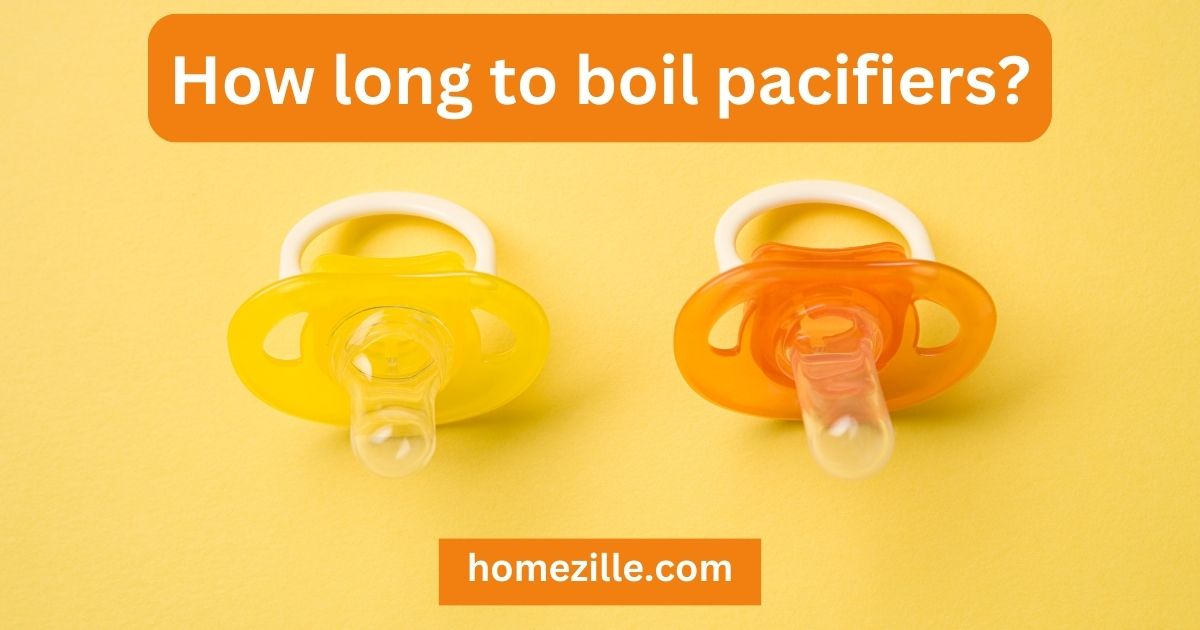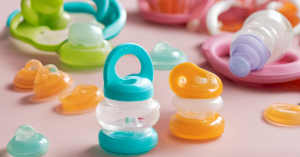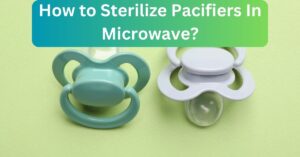Babies are especially likely to get sick, so it’s important to keep them safe from bacteria, viruses, and other dangers that can easily get on their pacifiers.Make sure your child and their own beloved pacifier are safe by following our advice on how to cleanse the pacifiers. Putting a pacifier in boiling water is one of the easiest or even best ways to clean it.
Sterilize Before First Use
The term “sterilization” refers to the process of completely removing all microorganisms from an item, such as a pacifier or another baby item, including those that aren’t necessarily toxic to humans.
Before using a pacifier for the first time, always sterilize it first.This will ensure that any bacteria or other substances that the pacifier may have picked up from the factory are eliminated.
How Long to Boil Pacifiers?
The process of sterilizing a pacifier by placing it in boiling water is one of the most straightforward and well-known methods.
- After bringing a clean pot of water to a full boil – which indicates that the water is bubbling vigorously – insert the pacifier in the water very carefully for a period of five minutes.
- Remove with caution using a squeaky-clean kitchen large spoon or ladle. When working with water that is boiling or very hot, always practice extreme caution!
- If there is any additional water in the pacifier teat, you can release any excess water by gently squeezing the tube flat and far from you (as the water may still be hot).
- Clean towels or a new drying rack can be used to dry your items.
- Before offering it to your child, check that the soother or the pacifier has completely regained its original temperature.
- You also have the option of placing the pacifiers in a clean container that is resistant to heat. Add the boiling water and continue with the procedure described above.
Table of Contents
Avoid prolonged sterilization:
Avoid subjecting the pacifier to prolonged sterilization and cleaning it with any kind of harsh detergent if you want it to remain in pristine condition.

Before giving your child or toddler a pacifier, make sure it is in proper working order. Before you use it for the first time, I advise you to sanitize it by putting it in a pot of boiling water for a period of no more than five minutes.
It is important to do this in order to eliminate any residue or dirt that may have been left over from the manufacturing process of the pacifier.
Because every pacifier has a valve, you need to make sure that any excess water is squeezed out of the socket part.
How Long to Boil Pacifiers For Thrush?
What Is Thrush?
A yeast infection known as thrush can frequently be found in a baby’s mouth. The thrush manifests as elevated whitish-gray patches that have the appearance of cottage cheese or milk curds.
They can be found on the gums, cheeks, and tongue of a baby if one looks closely enough. These spots won’t come off, and if you try to remove them, your skin could end up becoming irritated and red.
Your infant might experience discomfort while sucking if there are a lot of these patches, which could cause them to drink less.
Causes of Thrush:
Thrush is caused by Candida albicans, a microbe.When it occurs in the mouth, it’s normal. It is usually harmless, but an illness, antibiotic use, or hormonal changes can cause the yeast to grow and cause infection symptoms.
Thrushes can appear at any time, for no apparent reason. The doctor should be contacted if this occurs.
Treatment for Thrush:
Nystatin, a liquid medicine, is usually used to treat thrush. With a syringe or a sponge, you put Nystatin in each cheek of your baby’s mouth.
Give after your child has eaten and as your doctor has told you. The medication should still be taken, even if the spots have faded.
After taking the medicine, the thrush should go away. If your baby has problems eating or if the spots don’t go away after a week, you should call the doctor.
Boiling Pacifiers For Thrush
The majority of parents choose to sterilize the pacifiers by placing them in boiling water for a few minutes.
This is an excellent method provided that you are confident that the pacifier will not release any potentially harmful chemicals while it is being heated.
Take Note If you choose to use this method, you will need to ensure that the pacifier has had sufficient time to cool down before you offer it to your child.
In all likelihood, this will take a lot longer than you expected. Instead of squeezing the nipple to determine the temperature, you should try shaking any water that may be trapped out onto your wrist.
Note:
To prevent a return of the thrush infection, this step must be repeated at least once every four days. Everything the baby eats or drinks should be sterilized, including pacifiers, bottles, and anything else the baby touches. They need to be boiled for 20 minutes each day to ensure that any yeast that might be on them is killed off.
How Long To Boil Pacifiers to Disinfect?
Cleaning pacifiers:
Dr. Sherman says “it’s not likely that your baby will get sick because of a dirty pacifier, however it’s still important to maintain a clean environment, so do your best.”
Dr. Sherman has been a family doctor for more than 15 years and has helped people of all ages. He works hard to build long-term relationships with his patients so he can give them the best care and treatment for their unique conditions.

Thrush, an important fungal infection that causes the baby’s mouth to become sore and white, can be spread by using a dirty pacifier.According to Dr. Sherman’s advice, you should always wash the pacifier before reusing it on the baby’s mouth.
“You might not want to run the risk of the baby getting sick.”
Germs can get on a pacifier if it falls on the floor, a tabletop, a car seat, or any other surface that isn’t perfectly clean. Those germs could be bacteria or viruses that can make you sick.
Should you be sanitizing pacifiers?
Though it may seem daunting at first, cleaning a pacifier is actually quite simple. There’s no need to vigorously boil them or use a special sanitizer to get them clean.
Dr. Sherman recommends a simple scrubbing with hot boiling water and dish soap.
Boiling Pacifiers to Disinfect:
Most germs can be killed and the pacifiers disinfected in five minutes of boiling water. Once they’ve been rinsed thoroughly and drained, put those on a fresh, dry surface to air-dry.
A question arises that pacifiers can become disinfectant by only means of boiling water?No, absolutely not, there are different methods of disinfecting pacifiers. These are presented as:
The Dishwasher:
The conventional routine of cleaning in steam and then drying should be sufficient. However, you can also use the sterilize setting on your dishwasher to provide an additional layer of defense, which is especially important if the load contains dishes that have been in contact with raw poultry or any other potentially infectious substances.
Note: Verify the instructions that the manufacturer has provided for you before tossing the pacifier in the dishwasher.
A UV Sterilizer Box:
Several manufacturers of baby products have come out with UV sterilizer boxes that can sanitize baby items, such as pacifiers, in under a minute and get rid of 99.9 percent of all germs that could be harmful to the child. On the other hand, this recommendation is normally reserved for pacifiers that have already been cleaned properly.
The Microwave Method:
The microwave is yet another convenient and speedy method for sterilizing pacifiers.
- Put the pacifiers in a bowl, make sure the bowl and pacifiers are both safe to use in the microwave.
- Heat the pacifiers in the microwave for two to three minutes.
Precaution: certain pacifier brands strongly discourage using the microwave for cleaning.
- Wait for another two to three minutes, until the bowl is able to be handled without burning your hands, before pouring out the water.
- Now allow the pacifiers to dry on a surface that is both clean and dry.
- Use only hot water and detergent for cleaning solutions. After the pacifiers have been either sterilized or washed, make sure they are completely dry before putting them away in order to prevent the growth of bacteria.
Precaution: Moisture in pacifiers and various other baby products allows the growth of germs.
Here’s What Not to Do When Sterilizing Pacifiers
You are now familiar with the correct procedures for sterilizing a pacifier; however, what about the things that you should absolutely not do? In general, it is recommended that the guidelines listed below be followed.
- A pacifier thrown on the ground or in the park mud should be cleaned as soon as possible; don’t wait even for five minutes. However it is not necessary to adhere to the rule.
- The pacifier does not have to be sterilized every time, but you should, at least wash it with hot water and soap.
- If you happen to have a special cleaning wipe on you, and you don’t worry about it containing any harmful chemicals or toxins, you can try using it. Do not use already-used wipes.
- It’s not a good idea to stick the pacifier in your own mouth to clean it because you could end up transmitting germs to the baby.
- Pacifiers should be thrown away once they show signs of being worn out, cracked, or compromised in any other way.
- Do not tempt your child to use their pacifier by soaking it in their preferred flavor in an effort to get them to use it. This will only serve to frustrate your efforts. When food is placed on an unsterilized pacifier, bacteria can begin to grow on the pacifier. Try freezing fruit and vegetables or some of your child’s favorite meals and offering it for them to suck on if they want to eat something other than a pacifier. Their thirst for a pacifier will be satisfied by this, which is both tasty and non-toxic.
How long do Pacifier last?
Pacifiers should be changed every 4 – 6 weeks for hygienic and safety reasons, according to doctor’s recommendations.
When a pacifier appears to be deteriorating in any way, you should replace it as soon as possible if you notice any changes in its surface, size, or shape.
Before using the pacifier, make sure to pull the nipple in all different directions, inspect it thoroughly, and replace it as soon as you notice any signs of damage or weakness.
When to replace pacifiers
When it’s time to switch out the binky, you’ll probably notice.
You’ll notice that the texture is off and grainy.
They’ll start to age.The structure may not change if the baby doesn’t sucke too hard.
All kinds of shapes and dimensions are available in pacifiers. A binky was stuffed into the mouth of a 1-year-old girl before I started to catch on with my child.
That was the age range for the pacifiers she was using. Replace pacifiers when your child reaches the recommended age range for each of these sizes.
Newborn, 0-3 months, and 0-6 months are all common ages for use of pacifiers. Due to the general lack of safety provided by the smaller sizes, including for older kids, the small numbers can pose a risk.
Having a baby includes a significant amount of housework, as you will quickly discover. Make a routine to sanitize and clean baby items like bottles and pacifiers on a weekly basis to make life easier.
Microwavable bottle sanitizing kits were available when my daughter was younger, and I used them to clean her bottles and pacifiers at the same time.
They were as good as new after only thirty seconds! Whatever method you use to clean your baby’s things, make sure you do it correctly. Keep on cleaning!
Up to What Age should I Keep Sterilizing the Pacifiers after Every Feed?
The recommendations provided by official bodies are subject to change and can differ from one nation to the next; however, in general, the following is advised to be done:
- Pacifiers should be sterilized until the child is between 6 and 9 months old. Pacifiers intended for newborns and infants of a younger age should be sterilized every day.
- When your child enters the “oral phase,” also known as the stage in which everything is placed in his or her mouth, the frequency with which pacifiers should be sterilized should be decreased, and they should be cleaned using hot water and detergent.
- Harsh detergents can cause the material to become brittle, so don’t use a dishwasher to clean your items.
Disadvantage of using old Pacifiers
There is an additional hygienic justification for periodically switching out the pacifiers for new ones.
The longer the pacifiers are being used and the aged the child, the more bacteria they will accumulate.Because of this, I strongly suggest that you stop using a pacifier after your child has reached the age of 12 weeks.
Tips:
- Always check the pacifier before using it.Because every child is unique, the force with which they sucking their pacifiers can vary greatly. Because of this, you must always inspect the pacifier before giving it to your child to make sure there are no clear indications of excessive wear.
- Check to see if the rubber isn’t loose and that it’s securely attached. First and foremost, you should take care of this. The rubber needs to be thrown away as soon as possible if it has any dental marks, cracks, or other signs of wear and tear.
- Your child’s safety is at risk when you give him or her a pacifier with obvious damage.
Warnings:
The following are some of the most common warning signs that the pacifier your baby is using needs to be replaced:
- The pacifier starts to take on a darker hue, and it also starts to grow in size.
- Normal wear and tear on a pacifier made of natural rubber can easily cause it to grow by half a centimeter.
- There is also the possibility that the material will start to feel “glued” together, which is another sign that it needs to be replaced.
- Your child’s pacifiers will have a longer lifespan if you take proper care of them. When going on a trip, the pacifiers must be stored in a container that offers some form of protection, such as a pod or a suction box.
Tip: In addition, a pacifier clip should always be used for the baby. Pacifier clips are an indispensable accessory for keeping your child’s pacifier off the ground.
Choosing the Right Pacifier; How to Decide?
Silicone pacifiers vs. Natural latex rubber pacifiers:
Pacifiers made of silicone and latex tend to last longer than those made of other materials. Even though latex is more difficult to bite into, silicone baby pacifiers can last up to three times as long as latex ones.
Both types of materials, on the other hand, have their advantages and disadvantages.
Consider switching to a latex pacifier if you are concerned that the teeth of your child could puncture the silicone pacifiers if they are particularly sharp. The most recent pacifiers made of natural rubber are a light brown or yellow color. They darken, grow larger, and become more sticky over time, even if they aren’t being used.
Natural rubber latex, in contrast to silicone nipples, is a natural material that is affected by sunlight, high temperatures, and moisture, which accelerates the process of aging of the latex material.
As a consequence of this, the material undergoes a transformation, during which it may become fragile or sticky. It is necessary to purchase a new pacifier whenever there is a shift in the composition of the material.
You might or might not be sterilizing the natural rubber pacifier that your child uses, but whether or not you do, you should think about how to store the pacifiers when they are not being used.
The proper storage method entails ensuring that the pacifiers are kept dry at all times, as well as storing them in a cabinet that is dark, cool, and not overly warm..
You should replace your natural rubber latex pacifier if you notice any of the following indications:
- Surface alterations.
- Variations in the dimensions The material breaks down and becomes brittle or sticky, depending on the form variation.
- Pacifier becomes longer.
Conclusion:
I would like to take this opportunity to remind you that pacifiers are an excellent item to have on hand for young children.
The child experiences mental calmness, relaxation, and tranquillity as a result of using a pacifier. In order to reap the benefits of pacifiers without putting your child at risk, it’s important for parents to take care of their children’s items and swap them out at the appropriate times.
FAQs
Any tips to Prevent Thrush?
It is critical to bring reusable pacifiers and nipples to a boil for ten minutes, and then allow them to cool completely, before giving them to your child to use again.
An additional effective method is to run them through the dishwasher. Be sure to clean, as well as the hands of the baby, frequently and thoroughly.
Do unopened pacifiers expire?
After three months of use, pacifiers should be discontinued. Due to the general chemicals in the latex/silicone, they should never be used for over two years (same as with bottle nipples).
If you don’t know their age, the risk is too high. Your baby could choke on them if they dry out, fall off, or become loose.
WHY SHOULD I CHANGE MY CHILD’S PACIFIER?
I get a lot of emails from worried parents who aren’t sure how frequently they should be changing their child’s pacifier.
After eight to twelve weeks of use, despite these factors which of course can vary greatly depending on how frequently and how forcefully the baby sucks on the pacifier, I always recommend that the pacifier be replaced after a certain amount of time.
The primary reason why old, worn out pacifiers need to be thrown away is that, over time, pacifiers become worn out and porous, and as a result, they are more likely to break.




